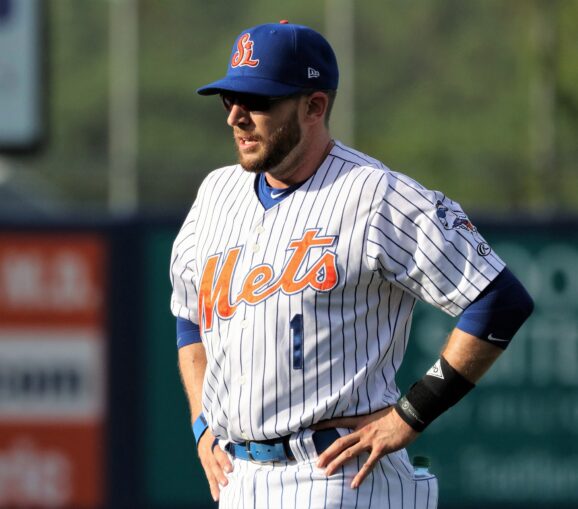
Photo by Ed Delany, MMO
New York Mets general manager Brodie Van Wagenen made a roster-strengthening, yet slightly puzzling move adding infielder Jed Lowrie to a two-year, $20 million free-agent contract last offseason. How things have turned out since is about as odd as Yoenis Cespedes‘ run-in with that now-infamous boar.
Despite the curiosity of the addition (the Mets infield was virtually at capacity at the time of the signing), bringing in a guy who hit .272/.356/.448 with 37 homers, 86 doubles, 168 RBIs over the course of 2017 and 2018 — complete with a 2018 AL All-Star nod — while staying healthy throughout (an issue in the past for Lowrie) was, in a vacuum, a good thing.
A capable fielder at second and third base (1 DRS, 5.6 UZR/150 at second base in 2018, -2 DRS, -7.9 UZR/150 at third), with a potent bat, to boot, Lowrie’s presence in any role was pegged as a plus for this roster. Unfortunately, that scenario never quite materialized.
From the start of Spring Training, Lowrie was bothered by injuries. What began as left knee pain, forcing him to miss all spring workouts and begin the season on the IL, eventually evolved into much more.
What followed was an at-times baffling array of afflictions affecting his left hamstring and right calf, as well as a mysterious left-side issue that Van Wagenen chalked up to “the kinetic chain” and “posture and functionality” (per Newsday).
When Lowrie finally did make his long-awaited debut for the Mets in early September — four games back of an NL Wild Card spot at the time — his impact was minor, if registerable at all. Over eight pinch-hitting appearances, he was o-for-7 with a walk and didn’t play an inning in the field.
Having already invested $11 million in Lowrie with no return whatsoever last season with another $9 million owed, the Mets now find themselves in a peculiar predicament heading into the 2020 season.
As Lowrie himself intimated to reporters at the time of his activation (New York Post), making an impact with the Mets is “the whole point; that’s why I’m here”. Though, how long he stays here is far from assured.
Early on this offseason, Ken Rosenthal of The Athletic noted that Van Wagenen & Co. were considering attaching either Lowrie or right-handed reliever Jeurys Familia (set to make $11 million in 2020) to a pre-arbitration player (Dominic Smith was mentioned as a potential candidate) to shed payroll and/or acquire talent to fill more-pressing areas of need.
Agree or disagree with that course of action, it’s an idea, nevertheless. Subtracting affordable production from their major-league talent pool in a Smith or J.D. Davis just to move money seems counterintuitive, but that’s just me.
Oakland (via Susan Slusser, San Francisco Chronicle) and Texas (Rosenthal) have reportedly shown interest in acquiring Lowrie, but any momentum towards a deal appears to have quieted in recent weeks.
As for him remaining in Queens, there’s still no room for Lowrie in the Mets’ infield, but his switch-hitting bat and defensive versatility on the bench could be a godsend for skipper Carlos Beltran this season.
Plugging a healthy Lowrie into the game as a pinch-hitter or late-inning replacement could reap positive effects in both the short and long-term. A clutch hit is great, as is conserving the energy of a (hopefully) healthy but aging Robinson Cano over the course of a long season, and there’s always the added insurance against injuries.
With Spring Training 2020 kicking off in just over five weeks, we’ll presumably have a resolution on this front in short order. Presumably, of course.















